
|
Sale 91
June 2016 Pre-Long Beach
| Lot |
Photo |
Description |
Realized |
Lot 2273 |
 |
Great Britain. Noble, ND NGC AU58. S.1743; Fr-109. Henry V, 1413-1422. Series D. Obverse: King stands facing in ship, bearing sword and shield. Annulet by sword arms, trefoil by shield, broken annulet on ship. Reverse; Floriated cross. NGC graded AU-58. Estimated Value $7,000 - 9,000
Ex: Maltergaleries Sale 86, 14 Nov. 2004, Lot 760.
View details and enlarged photos
| Realized
$6,933 |
Lot 2274 |
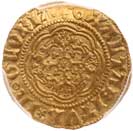 |
Great Britain. Quarter Noble, ND NGC MS62. S.1810; Fr-114. Henry VI, 1422-1461. Annulet issue (1422-27). London. Mint mark, Lis. NGC graded MS-62 Gold Wings. Estimated Value $1,250 - 1,500
View details and enlarged photos
| Unsold |
Lot 2275 |
 |
Great Britain. Noble, ND NGC Unc. S.1799; Fr-112. Henry VI, 1422-1461. Annulet issue. Obverse, king standing facing in ship, holding sword and shield. Reverse, floriated cross with lis at ends. A superb coin with an exceptional portrait of the king. All detail is well struck up with handsome surfaces and much original luster. A mint state specimen with great eye appeal. NGC graded Uncirculated, Details (Surface Hairlines).
* This coin was struck at the London mint, in the first few years of the king's reign. Henry VI was King of England from 1422-1461 and then again from 1470-1471. In his first reign the Noble, Half Noble and Quarter Noble were issued, in the second reign the gold Angel and Half Angel were minted.
Henry VI was also the (disputed) King of France 1422-1453, and consequently, gold (and silver) coins were made at the Calais mint as well as the English mints of London and York.
The only child of Henry V, Henry VI succeeded to the English throne at the age of 9 months upon his father's death. He inherited a restless kingdom and a long-running conflict (The Hundred Years' War) with France.
Henry was not suited to the task of governing mediaeval England. Eventually, as the war with France began to fail he experienced a mental breakdown. Civil war broke out in 1460, leading to the prolonged War of the Roses. He lost the throne in 1461 only to be restored in 1470. He died aged 49 on 21st May 1471 after being toppled by Edward IV, and was probably murdered on Edward's instructions. Estimated Value $6,000 - 7,000
View details and enlarged photos
| Unsold |
Lot 2276 |
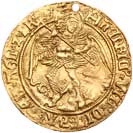 |
Great Britain. Angel, ND NGC Unc. S.2265; Fr-158. Henry VIII, 1509-1547. First coinage, mint mark Portcullis crowned. Pierced for use as a touchpiece. Obverse, St Michael slaying dragon. Reverse, ship with coat of arms. Obverse appears to be struck from rusty dies, but surprisingly high grade. NGC graded Uncirculated, Details (Holed, Cleaned).
* Persons of royal blood were thought to have a 'God given' power of healing various illnesses by touch, and the gold Angel coins which were first struck in Britain in 1465 are found officially pierced, to be used as touch pieces by the monarch.
The Angel was a coin favoured at the 'Touching' ceremonies because it has an image of St Michael slaying the Devil (represented as a dragon). St Michael was especially venerated for his role as a captain of the heavenly host that drove Satan out of Heaven, but he was associated with the (broader) practice of casting out of devils, and was also regarded as a guardian of the sick.
Henry VII codified past practices into a 'Divine Service' thereby creating a Touching Ceremony which lasted, barely changed, for 160 years. To replace the alms which were previously given to the sick there was now a gold coin or healing-piece. To an extent the pierced Angel coin assumed magical powers. His successor, Henry VIII was regarded as the author of the debasement of England's gold and silver coinage, but it is interesting to note that although Henry debased the coinage by reducing its weight, he kept the weight of the Angel consistent. Estimated Value $1,500 - 1,700
View details and enlarged photos
| Unsold |
Lot 2277 |
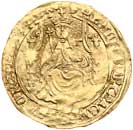 |
Great Britain. Half Sovereign, ND NGC AU50. S.2297; Fr-167. Henry VIII, 1509-1547. Third coinage (1544-1547). Southwark. Obverse, king facing, seated on throne holding orb and sceptre. Reverse, crowned shield of Tudor arms. Weakly struck in parts (as usual) but with a stunning portrait of the king and practically as made. NGC graded AU-50. Estimated Value $6,000 - 7,000
View details and enlarged photos
| Unsold |
Lot 2278 |
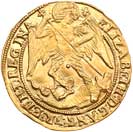 |
Great Britain. Angel, ND NGC Unc. S.2525; Fr-211. Elizabeth I, 1558-1603. Fifth issue. Mint mark, Latin Cross over Greek Cross. Obverse, St Michael standing, slaying the dragon: + ELIZABETH: D: G: ANG: FR: ET: HI: REGINA. Reverse, ship bearing shield of arms and cross. E and rose at sides: ADNO FACTUM EST ISTUD ET EST MIRABI (a shortened version of the Latin legend meaning 'This is the Lord's doing and it is marvellous in our eyes,' Psalm 118.23). Mint state. Nicely struck up, and well centred on a good large planchet, this coin glistens with original luster. Unusually detailed portrait of St Michael.Rarely seen so fine. NGC graded Uncirculated, Details (Obverse Scratched).
*This coin was struck in the period 1580-1581 when the Queen began to feel threatened by the forces of Catholicism. Consequently, from the early 1580s, the previously lax enforcement of anti-Catholic laws became stricter and people were persecuted and executed for their faith.
Some of the priests who had been smuggled into England and caught, rightly claimed that their mission was solely to minister to fellow Catholic souls and went to their deaths proclaiming their loyalty to God and the Queen. But many priests were in fact plotting against her and Elizabeth also rightly claimed that for her the question was not about religion but the stability of the kingdom. To put things in perspective, in the 45 years of her reign three hundred Catholic martyrs died for their faith, but her sister ('Bloody') Mary had killed the same number of Protestant martyrs in a six year reign!
A few years later in 1587 the woman who was the constant focus of plots against Elizabeth, Mary Queen of Scots, was executed, and in 1588 Philip of Spain launched his ill-fated Armada against England. The Armada failed, and a certain stability returned to England. Estimated Value $6,000 - 7,000
View details and enlarged photos
| Unsold |
Lot 2279 |
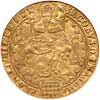 |
Great Britain. Rose-Ryal of 30 Shillings, ND NGC AU58. S.2613; Fr-230. James I, 1603-1625. Second coinage. Mint mark, Tower (1612-1613). James enthroned facing, holding sword and scepter, portcullis at feet. Reverse; Shield on large Tudor rose. A marvelous example of this rarity, on a full flan, crisp strike with details being sharply defined. Rare. NGC graded AU-58. Estimated Value $20,000 - 25,000
View details and enlarged photos
| Realized
$24,675 |
Lot 2280 |
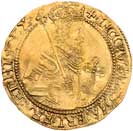 |
Great Britain. Unite, ND NGC MS62. S.2620; Fr-234. James I, 1603-1625. Second coinage, 5th bust. Mint mark plain cross. Obverse, half-length bust of king with longer hair in armour, right, holding sword and sceptre. Reverse, crowned square garnished shield with I R (Iacobus Rex) at sides. Legend reads: FACIAM EOS IN GENTEM UNAM (I will make them one nation: Ezekiel, 37,22) A well-produced coin on a large round flan/planchet with an outstanding portrait. Some evidence of double striking, as is often the case with this issue, but the lettering is crisp and clear and the eye appeal undeniable. NGC graded MS-62.
* This coin was made in the period 1618-1619, and in 1619 the Unite was replaced by a new lighter 20 shilling gold coin - the Laurel.
James I had been King of Scotland since July 1567 (when he was 11 months old) and King of England from 1603. Indeed, he could not remember a time when he was not King! It is hardly surprising therefore that he had a high opinion of himself.
James said of the monarchy: 'The state of monarchy is the supremest thing upon earth, for kings are not only God's lieutenants on earth and sit upon God's throne, but even by God himself they are called gods. …I conclude then this point touching the power of kings with this axiom of divinity, that as to dispute what God may do is blasphemy…so it is sedition in subjects to dispute what a king may do in the height of his power.' These comments serve to explain how James and his son Charles I could never see beyond the 'Divine Rights' of the monarch, and demonstrate how the confrontation with the forces of parliament became almost inevitable. Estimated Value $4,000 - 4,500
View details and enlarged photos
| Realized
$5,170 |
Lot 2281 |
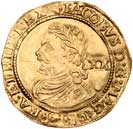 |
Great Britain. Laurel, ND NGC MS63. S.2638C; Fr-242. James I, 1603-1625. Third coinage. Fourth head variety. Mint mark Lis (1623-4). Obverse, draped bust of king left, mark of value (XX) behind. IACOBVS D:G: MAG: BRI: FRA : ET HIB: REX. Reverse, crowned shield of arms. FACIAM EOS IN GENTEM UNAM. This is a sharply struck mint state coin which glistens with original luster. The portrait is exceptional and the reverse shield beautifully detailed. NGC graded MS-63.
*This Laurel of 20 shillings was produced within a year or two of the end of James's reign, in the period 1623-1624. James died in March 1625, sadly, a prematurely senile figure at the age of 59, and was succeeded by his son Charles I. James was not a popular or beloved King of England, nor was he a popular King of Scotland, though overall he did succeed better in his northern realm. For some Scots he was the great betrayer who sold their birthright to the English. For others, who did not object to the union of the two crowns, his betrayal lay in settling in London rather than Edinburgh, and thereby reinforcing the eminence of the English capital and English domination.
But generally it was agreed that this unlikely monarch had succeeded where his more illustrious forebears - and English cousins - had failed. If he was not in fact the King of Great Britain, he had peacefully united the 2 crowns into a dual monarchy. Estimated Value $4,000 - 4,500
View details and enlarged photos
| Realized
$5,875 |
Lot 2282 |
 |
Great Britain. Unite, ND PCGS About Unc. S.2692; Fr-246. Charles I, 1625-1649. Tower mint under the King. Mint mark, Crown (1635-6). Obverse smaller bust of king left. Reverse, crowned shield. A pretty coin struck on a large full flan/planchet, a little weakly made in parts, but crisp in other areas and probably nearly Uncirculated for this crudely produced issue. The king's portrait is excellent. PCGS graded About Uncirculated, Details (Cleaned). Estimated Value $3,000 - 3,400
View details and enlarged photos
| Unsold |
Lot 2283 |
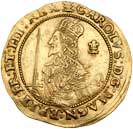 |
Great Britain. Triple Unite, 1643 (Oxford) NGC AU50. S.2726; Fr-258. Charles I, 1625-1649. Half-length crowned artistic bust of King left, in armour, with scarf flying from shoulder, holding a sword in one hand and an olive branch in the other, plume behind portrait. Mint mark Oxford plume above. Obverse legend reads: CAROLVS: D:G: MAGN: BRIT: FR: ET: HI: REX. Reverse has declaration in three lines on scroll RELIG: PROT LEG: ANGL: LIBER: PAR, with value (III) and 3 plumes above, date below. The Latin translation underlines the King's promise to preserve the Protestant religion, the laws of the land and the privileges and freedom of Parliament. The coin has an evenly struck portrait and superb reverse detail. Both obverse and reverse surfaces glisten with original luster. Struck on a full flan, and in virtually mint state for this issue.
The Charles I Triple Unite is probably England's most impressive denomination, and one of the nation's most important and historically significant numismatic rarities. It is estimated that there are only around 225 Triple Unites in existence, and this relatively small figure includes several different types and varieties. This piece is remarkable because it is a rarer type than is normally encountered, but has none of the double-striking associated with the variety. This coin does however have the same small irregular raised marks (die 'pimples') in the obverse field in front of the King's face as the J.Pitman/Samuel King, Schneider and Millennia Collection specimens, which demonstrates that very few coins of this type were made. NGC graded AU-50.
*Charles made his headquarters in the city of Oxford late in 1642 at the height of the English Civil War and produced his coinage there. After the king's final break with Parliament, the parliamentary authorities, still using the king's name and effigy, continued to manufacture coins in London. This only ended after the king's execution in early 1649.
Lamenting the fate of Charles I one scholar expressed surprise that 'so good a man should be so bad a king.' Despite the magnificence of much of Charles's coinage the king was not over-endowed with money. For a long time the welfare of England and the raising of money by taxation had depended on some sort of balance being maintained between monarch and Parliament, something that neither James I nor his son Charles ever began to understand.
Charles lectured the first assembly that lack of funds forced him to call in 1625, 'Remember that Parliaments are altogether in my own power for their calling, sitting and dissolution.' He was technically right, but his lack of tact and his arrogance sadly set the tone for the rest of his reign. This led to the ultimate confrontation with Parliament and eventually cost him his throne and his life. Estimated Value $90,000 - 100,000
View details and enlarged photos
| Realized
$105,750 |
Lot 2284 |
 |
Great Britain. Triple Unite Oxford, 1643 PCGS About Unc. S.2727; Fr-258. Charles I, 1625-1649. Half-length crowned detailed bust of King left, in armour, holding a sword in one hand and a long olive branch in the other, plume behind portrait. Mint mark Oxford plume above. Obverse legend reads: CAROLVS: D:G: MAGN: BRIT: FR: ET: HI: REX. Reverse has declaration in three lines on scroll RELIG: PROT LEG: ANGL: LIBER: PAR, with value (III) and 3 plumes above, date below.
There is tiny piece of raised excess metal in the reverse design above the 'O' of PROT. This is exactly the same as on the reverse of the Herbert Schneider Collection specimen (plate 24, No. 295) and shows that both coins were struck from the same reverse die. This is a handsome specimen with practically no sign of wear and approaching mint state. PCGS graded Genuine About Uncirculated, Details (Cleaned).
As well as being the largest denomination ever produced in England at the time, the Triple Unite was also the most impressive. With a value of 3 pounds or sixty shillings, it was probably not expected to circulate extensively. Nevertheless, these rare coins now appear in various grades from fine to mint state. This is one of the higher grade specimens extant, and will likely form the centrepiece of a high quality British coin collection.
Charles I moved his Mint to Oxford soon after the English Civil War began, and the Triple Unite was probably quickly produced as something of a propaganda coin.
Scotland's victory over England in the Second Bishops' War left King Charles very short of cash, and from 1640 he tried to cajole Parliament into granting further revenue. He refused to allow Parliament's militia bill to pass into law, however, as this would have conceded his control of the army and navy.
In January 1642 Charles tried to arrest the 5 Members of Parliament whom he regarded as his leading opponents, but there were riots and armed opposition, and the King was forced to flee London, eventually settling in Oxford. The Civil War began in August 1642. The Royalists occupied Oxford and several University buildings were taken over by the King, his court and military chiefs. The King stayed at Christ Church Hall, and the Privy Council met at Oriel College. All Souls College became an aresnal and New College became a gunpowder store. The Mint was set up in New Inn Hall.
As the English Civil War continued, Charles I tried to undermine Parliament's power and authority by establishing an alternative parliament in Oxford, but this was never a success.
In March 1644 the Oxford Parliament tried to begin peace negotiations, but this failed because the Westminster Parliament refused to recognise its legitimacy. Relations between the Oxford Parliament and the King were strained, Charles ordered the arrest of Lords Percy, Andover and Sussex, in a display of anger after further calls for peace talks. Charles adjourned the Oxford Parliament in March 1645, describing it as 'our mongrel parliament' in a letter to his wife. It was scheduled to meet again in October 1645, but by then Charles had lost the war.
Meanwhile, the Parliamentarians had divided into the 'Presbyterians' who wanted to negotiate with Charles, and the 'Independents' who wanted to defeat him totally. In 1645 the Independent faction began an overhaul of the armed forces and the efficient 'New Model Army' decisively beat the Royalists. King Charles eventually surrendered to the Scots rather than to Parliament, but his fate was sealed. Estimated Value $60,000 - 70,000
View details and enlarged photos
| Unsold |
Lot 2285 |
 |
Great Britain. Charles II pattern gold Broad, 1660 PCGS Proof 63. North-2777, Montagu-818 (Sotheby, London, November 1896), KM-Pn30. By Thomas Simon. Reeded Edge, signed "S" beneath the portrait, 30 mm, The stunning reverse legend MAGNALIA DEI translates to mean "The Mighty Acts of God." An astonishingly well-preserved specimen, likely finest known, and of numismatic importance as a gold pattern of similar statue to the famed Petition Crown struck in silver. The collecting opportunity of a lifetime to acquire this historically significant and beautifully made coin! PCGS graded Proof 63+ (Heavy Cameo not noted on grading insert).
When Prince Charles landed at Dover on May 25, 1660, he knelt down and kissed the English soil. It was far more than a merely symbolic gesture. It was a singular event in English history, the moment that set in motion the restoration of the monarchy throughout the land. A month before, Parliament had resolved to proclaim him King Charles II so long as he adhered to the Declaration of Breda pardoning many of his father's enemies and relinquishing the historical, absolute powers of the monarchy. He arrived in London four days later, on his 30th birthday.
There was a great deal to forgive. When he was 18 years old, his father had been beheaded for "treason" in the winter of 1649. He was the only surviving son of his parents, natural heir to the Court of St. James. That right evaporated upon his father's execution. As a teenager, he had accompanied his father during the late campaigns of the Civil War, and had witnessed the end coming. Charles and his mother, Queen Henrietta Maria, had been exiled in 1646 to France and protected by his first cousin, King Louis XIV, during the final years of the war, and all during the Commonwealth and then the disastrous reign of Oliver Cromwell. When Cromwell died, his son, Richard, had shown himself to be feckless. The nation stood in ruins. Cromwell had crushed royalist supporters but Charles II pardoned many who had ransacked the country, only taking revenge on a few dozen of Cromwell's most offensive military and legal supporters.
Charles II was the first of a new breed of monarchs, and much of his passion was devoted to the arts despite the catastrophes of the first years of his reign, including the plague and the Great Fire of London, as well as external wars. He began building what eventually became the royal art collection of paintings, and he was a magnanimous patron of the flourishing sciences as well as of architects such as Christopher Wren. He took a particular personal interest in sculpture and in the engraving arts as well, to which the superb artistry of his wonderful pattern attests, for it was a departure from the medieval style of engraving that had been stereotyped in its lifeless style and flat imagery. Here, instead, we see a lifelike image of the king replete with touching details shown in considerable relief and with artistic flair.
The fabulous work of engraving art seen in this lot, struck only as a pattern, was largely responsible for the introduction of the "milled," or machine-made, coinage as ordered by the King in Council on May 17, 1661, shortly after this piece was created. As the king is known to have taken a personal interest in his effigy, he may well have inspected this very coin, and it is known from contemporary sources that using Simon's superbly engraved dies to make the hammered coins drew considerable dismay from the mint itself: hammering the dies could not bring up the details that distinguished the die-work. It is plausible that this pattern stood as proof that hammering was obsolete as a minting technique.
The short-lived milled coinage using Simon's effigy of Oliver Cromwell and his shield, and struck by Blondeau, ended in August 1660 with removal from the mint of the milled machinery, no doubt partially as a result of jealousy by mint employees fearful of losing their positions as hammered workmen but also in response to the use of that machinery during the hated reign of Cromwell. Cromwell's coins, however, showed that the hammering technique was old fashioned and unable to forestall counterfeiting and the illegal shaving of metal from the uneven edges. A sea-change was in the works.
Thomas Simon, born circa 1623, was one of the sons of Peter Simon of Guernsey, whose older brother, Abraham, was also a medallist. He first came to the attention of Nicholas Briot about 1635 and was engaged as an apprentice at the Royal Mint, his first work being the "Scottish Rebellion" medal of 1639. As was the rule of the day, he also worked as a gem-engraver. His talents caused him to be appointed joint-engraver to the mint in 1645, just as the Civil War was changing England's greatest traditions. In 1648, he was authorized to engrave the Great Seal of the Commonwealth, and then in 1651 he engraved the new Great Seal of England, showing not a king's image but instead an intricately detailed map of England and Ireland on its obverse and, opposite it, a portrayal of Parliament assembled without a monarch. The surrounding legend on this piece proclaimed "1651 IN THE THIRD YEARE OF FREEDOME BY GODS BLESSING RESTORED." This sentiment surely enraged royalists, but in fact Thomas Simon only did as he was ordered, as an employee of the mint. During the Commonwealth, he mostly engraved seals and medals, and was politically neutral.
Simon came to Cromwell's attention immediately after the defeat of the Scots at the Battle of Dunbar (September 3, 1650), a great victory for the Commonwealth army. Simon's talent caused him to be ordered to make effigies of General Cromwell, to be used to strike gold and silver medals as awards to officers and soldiers who took part in the battle. This work was so well received that Simon was next selected to engrave dies for Cromwell's coins, struck from 1656 to 1658, the pieces that were so stunning compared to the coins made by hammer. One feature of Cromwell's coins that had never appeared before on any English coin was the cameo effect created by the frosted texture given to the portrait, and importantly this appears on our gold pattern of 1660 as well. Forrer's Biographical Dictionary of Medallists (volume 5, page 521) quotes an earlier source, Lee's Dictionary of National Biography, which stated that "The frosting observable on these coins appears to have been introduced by Simon."
But Simon's immense talent would not serve him ably enough during the Restoration. Thomas Rawlins was reinstated as chief engraver at the mint. In June 1660 he was ordered to prepare a new portrait of the king, but failed to do so on time, and Simon was given the assignment on August 10 of that year. His portrait was highly regarded but the hammering technique failed to produce coins that met with the mint's approval. His work, however, was so well appreciated that he was given the job of engraving dies for all the new milled coinage. Then came the fateful contest between him and John Roettier, of Flanders, in February 1662. Simon produced the magnificent and now famous Petition Crown, with its stunning royal image and the spectacular edge engraving that petitioned King Charles II to select Simon's work for the royal coinage. Perhaps remembering Simon's medal of 1651, the king himself decided in favor of Roettier, effectively ending Simon's employment at the Royal Mint. He died of the plague in June 1665.
Numismatics is an intriguing science, however, and research provides another explanation for Simon's demise. Challis responded to the traditional view that the king's bias caused Simon's talents to be rejected. A New History of the Royal Mint (pages 349-350) discusses the quality of the puncheons and other minting tools used to produce coins. Challis notes that while Simon's dies were splendid he "had demonstrated his inability to produce dies which would withstand the press" with its intense pressure, and in particular this was seen in puncheons that he produced for the Goldsmiths' Company of London, which annually contracted with him to make a set of three puncheons showing the company's mark, which included a facing leopard's head. In the early 1660s, Challis continues, "Simon's puncheons simply would not withstand normal use." In the end, it was all about economy. Simon blamed the rejection on the poor quality of the silver to which his puncheons were applied by the company, but "the real trouble lay in the inadequacy of the metal from which they were made." And here is the conclusion: "If such an explanation is correct it seems likely that it contains the key to why Simon, regarded by many from his own day to this as one of the finest engravers the Mint has ever had, lost out in the competition with the Roettiers. It was not that Simon was hopelessly disadvantaged at Court by his having willingly served the Protectorate. Rather it was that he could not match the Roettiers in being able to produce dies which, day in day out, would withstand machine production."
To our knowledge, it has not been pointed out before that, on this magnificent pattern, a work of art struck in gold, Thomas Simon placed the Goldsmiths' Company's mark, the face of a leopard, at the base of the king's throat, peering at the world in a silent petition to "remember me" centuries after King Charles and all his contemporaries perished - perhaps another artistic way of saying Magnalia Dei! Estimated Value $100,000-UP
View details and enlarged photos
| Realized
$317,250 |
Lot 2286 |
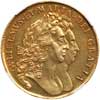 |
Great Britain. 5 Guineas, 1692 NGC AU53. S.3422; Fr-299. William and Mary, 1689-1694. Edge: 'QVARTO' Obverse; Conjoined heads of William and Mary right, William laureate. Reverse; Crowned, ornately garnished shield, with central small escutcheon, and shell "wings" at sides. Some surface marks, lustrous with reddish tone in the devices. NGC graded AU-53. Estimated Value $12,000 - 14,000
View details and enlarged photos
| Realized
$30,550 |
Lot 2287 |
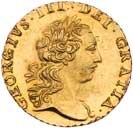 |
Great Britain. Quarter Guinea, 1762 NGC MS64. S.3741; Fr-368; KM-592. George III. Long haired laureate type right. GEORGIVS. III. DEI. GRATIA., reverse has inverted die axis, crowned quartered shield of arms with 6 strings to Irish harp, date at top. Edge obliquely grained. Superb mint state with a light golden tone. NGC graded MS-64. Estimated Value $1,200 - 1,400
View details and enlarged photos
| Realized
$1,528 |
Lot 2288 |
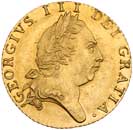 |
Great Britain. Half Guinea, 1790 NGC MS63. S.3735; Fr-362; KM-608. George III. Crisply struck mint state with lots of golden luster and much eye appeal. NGC graded MS-63. Estimated Value $1,100 - 1,300
View details and enlarged photos
| Realized
$1,645 |
Lot 2289 |
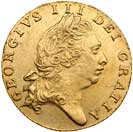 |
Great Britain. Half Guinea, 1802 NGC AU58. S. 3736; Fr-363; KM-649. George III. Obverse, laureate portrait of King right. Reverse, crowned shield within garter. A lovely well struck coin from the start of the 19th century. Practically as struck. NGC graded AU-58. Estimated Value $600 - 700
View details and enlarged photos
| Realized
$646 |
Lot 2290 |
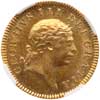 |
Great Britain. Half Guinea, 1804 NGC MS63. S.3737; Fr-364; KM-651. George III, 1760-1820. Seventh laureate head right. Reverse; Quartered shield of arms upon crowned garter, date below, legend surrounding. Fresh mint bloom with a pleasing light red tone. NGC graded MS-63. Estimated Value $1,000 - 1,200
ex A H Baldwin & Sons Ltd, Fixed Price List, Summer 2013, item BM033.
View details and enlarged photos
| Realized
$969 |
Lot 2291 |
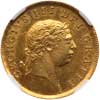 |
Great Britain. Half Guinea, 1804 NGC AU58. S.3737; Fr-364; KM-651. George III. Seventh laureate head right. Nice lustrous example. NGC graded AU-58. Estimated Value $500 - 600
View details and enlarged photos
| Realized
$541 |
Lot 2292 |
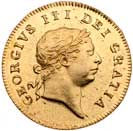 |
Great Britain. Half Guinea, 1809 NGC MS63. S.3737; Fr-364; KM-651. George III. Obverse seventh laureate head of king facing right. Reverse shield in garter date below. Upright die axis, edge obliquely grained. Mint state with reflective surfaces. Great eye appeal. NGC graded MS-63. Estimated Value $900 - 1,000
View details and enlarged photos
| Realized
$905 |
Lot 2293 |
 |
Great Britain. 'Military bust' Half Guinea, 1813 NGC MS65. S.3737; Fr-364; KM-651. George III. Specimen or Proof finish. Obverse, seventh laureate head with short hair, facing right. Reverse, shield in garter, date below. Upright die axis, edge obliquely grained. Superb mint state with somewhat frosted design and mirror fields. Well struck up, with good eye appeal (nicer than the lot 31259 Heritage auction 5th Jan 2016 NGC Proof 64) Rare date. NGC graded MS-65. Estimated Value $3,000 - 3,500
View details and enlarged photos
| Realized
$6,756 |
Lot 2294 |
 |
Great Britain. Half Guinea, 1813 NGC MS63. S.3737; Fr-364; KM-651. George III, 1760-1820. Seventh laureate head right. Reverse; Quartered shield of arms upon crowned garter, date below, legend surrounding. Fresh mint bloom with a pleasing light red tone. NGC graded MS-63+. Estimated Value $1,800 - 2,000
ex A H Baldwin & Sons Ltd, Fixed Price List, Summer 2013, item BM034.
View details and enlarged photos
| Realized
$1,586 |
Lot 2295 |
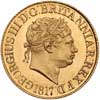 |
Great Britain. Sovereign, 1817 NGC MS64. S.3785; Fr-371; KM-674. George III. Obverse, laureate head of King right. Reverse, Pistrucci's St George and dragon. Lovely lustrous surfaces on this truly mint state coin. 1817 was the very first year of the gold Sovereign, and this is an exceptional example. NGC graded MS-64. Estimated Value $3,000 - 3,500
View details and enlarged photos
| Realized
$14,688 |
Lot 2296 |
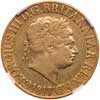 |
Great Britain. Sovereign, 1817 NGC VF35. S.3785; Fr-371; KM-674. George III. NGC graded VF-35. Estimated Value $700 - 800
View details and enlarged photos
| Unsold |
Lot 2297 |
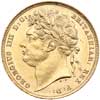 |
Great Britain. Sovereign, 1822 NGC MS63. S.3800; Fr-376; KM-682, George IV. Obverse, Pistrucci's portrait of King left. Reverse, St George and Dragon. Date in exergue. A well struck and glossy mint state example of the early Sovereign. NGC graded MS-63. Estimated Value $2,700 - 3,000
View details and enlarged photos
| Realized
$4,465 |
Lot 2298 |
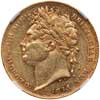 |
Great Britain. Sovereign, 1824 NGC AU50. S.3800; Fr-376; KM-682. George IV. Laureate head left. Reverse; St. George. A pleasing lustrous example with a hint of peripheral toning. NGC graded AU-50. Estimated Value $2,200 - 2,400
View details and enlarged photos
| Unsold |
Lot 2299 |
 |
Great Britain. Sovereign, 1825 NGC MS62. S.3801; Fr-377; KM-696. George IV. Obverse, bare headed portrait of king left. Reverse crowned shield of arms. A mint state coin with good eye appeal. Catalogues around $4700 in uncirculated. NGC graded MS-62. Estimated Value $2,500 - 3,000
View details and enlarged photos
| Realized
$3,525 |
Lot 2300 |
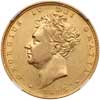 |
Great Britain. Sovereign, 1825 NGC EF45. S.3801; Fr-377; KM-696. George IV. Bare head left. Hint of mint luster. NGC graded EF-45. Estimated Value $1,500 - 1,700
View details and enlarged photos
| Unsold |
Lot 2301 |
 |
Great Britain. Sovereign, 1829 Fine. S.3801; Fr-377; KM-696. George IV. Bare head. Fine. Estimated Value $300 - 350
View details and enlarged photos
| Realized
$400 |
Lot 2302 |
 |
Great Britain. Sovereign, 1830 NGC MS62. S.3801; Fr-377; KM-696. George IV. Obverse, bare headed portrait of King left. Reverse, crowned shield of arms. Mint state with much original mint luster and great eye appeal. NGC graded MS-62. Estimated Value $2,500 - 3,000
View details and enlarged photos
| Realized
$3,878 |
Lot 2303 |
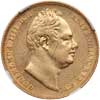 |
Great Britain. Sovereign, 1831 NGC EF. S.3829B; Fr-383; KM-717. William IV. NGC graded Extremely Fine, Details (Obverse Scratched, Cleaned). Estimated Value $1,000 - 1,200
View details and enlarged photos
| Realized
$1,528 |
Lot 2304 |
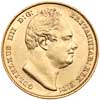 |
Great Britain. Sovereign, 1832 NGC AU58. S.3829; Fr-383; KM-717. William IV. Obverse, portrait of king right by Wyon. Reverse crowned shield of arms. Practically mint state and blemish free. NGC graded AU-58. Estimated Value $1,800 - 2,000
View details and enlarged photos
| Realized
$2,820 |
Lot 2305 |
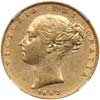 |
Great Britain. Sovereign, 1843 NGC AU53. S.3852; Fr-387e; KM-736.1. Broad shield. Victoria. Young head. NGC graded AU-53. Estimated Value $700 - 800
View details and enlarged photos
| Unsold |
Lot 2306 |
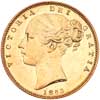 |
Great Britain. Sovereign, 1853 PCGS MS62. S.3852C; Fr-387e; KM-736.1. Victoria. Raised WW. Repunched A. Obverse, Wyon's young portrait of Queen left. Reverse crowned shield within wreath. The A in VICTORIA is over a sideways A and therefore this coin is very rare. Uncirculated with a light red tone. PCGS graded MS-62. Estimated Value $1,000 - 1,200
View details and enlarged photos
| Realized
$1,028 |
Lot 2307 |
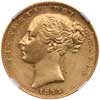 |
Great Britain. Sovereign, 1855 NGC AU50. S.3852D; Fr-387e; KM-736.1. "W.W." incused. Victoria. Young head. Reverse; Shield. NGC graded AU-50. Estimated Value $600 - 650
View details and enlarged photos
| Unsold |
Lot 2308 |
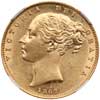 |
Great Britain. Sovereign, 1862 NGC AU58. S.3852D; Fr-387e; KM-736.1. Victoria. Young head. Reverse; Shield. Nice luster. NGC graded AU-58. Estimated Value $650 - 700
View details and enlarged photos
| Unsold |
Lot 2309 |
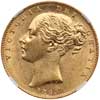 |
Great Britain. Sovereign, 1863 NGC AU58. S.3852D; Fr-387e; KM-736.1. No die number. Victoria. Attractive mint luster. NGC graded AU-58. Estimated Value $500 - 550
View details and enlarged photos
| Realized
$646 |
Lot 2310 |
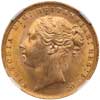 |
Great Britain. Sovereign, 1871 NGC MS64. S.3856A; Fr-388; KM-752. Victoria. Young head. Reverse; St. George. A pleasing example with frosty mint luster. NGC graded MS-64. Estimated Value $1,300 - 1,500
View details and enlarged photos
| Realized
$1,998 |
Lot 2311 |
 |
Great Britain. Sovereign, 1872 NGC MS64. S.3856A; Fr-388; KM-752. Victoria. Young head. Reverse; St. George. A lovely example with fresh mint bloom. NGC graded MS-64. Estimated Value $1,500 - 1,700
View details and enlarged photos
| Realized
$1,763 |
Lot 2312 |
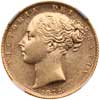 |
Great Britain. Sovereign, 1872 NGC AU58. S.3853B; Fr-387e; KM-736.1. No Die number. Victoria. Young head. Reverse; Shield. Reflective fields and lustrous. NGC graded AU-58. Estimated Value $650 - 700
View details and enlarged photos
| Unsold |
Lot 2313 |
 |
Great Britain. Half Sovereign, 1884 NGC MS62. S.3861; Fr-389e; KM-735.1. Victoria. Young head. Reverse; Shield. NGC graded MS-62. Estimated Value $500 - 600
View details and enlarged photos
| Unsold |
Lot 2314 |
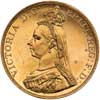 |
Great Britain. Five Pounds, 1887 NGC MS63. S.3864; Fr-390; KM-769. Victoria. Obverse, Boehm's 'Jubilee Head' of Queen left. Reverse, Pistrucci's St George and Dragon motif. Brilliant mint state with prooflike fields. NGC graded MS-63. Estimated Value $3,700 - 4,000
View details and enlarged photos
| Realized
$4,230 |
Lot 2315 |
 |
Great Britain. Sovereign, 1887 NGC MS63. S.3866; Fr-392; KM-767. Victoria. Jubilee head. Brilliant mint luster. NGC graded MS-63. Estimated Value $600 - 650
View details and enlarged photos
| Realized
$764 |
Lot 2316 |
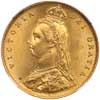 |
Great Britain. Half Sovereign, 1887 NGC MS65. S.3869; Fr-393; KM-766. Victoria. Jubilee head. NGC graded MS-65. Estimated Value $400 - 450
View details and enlarged photos
| Realized
$447 |
Lot 2317 |
 |
Great Britain. Half Sovereign, 1887 NGC MS64. S.3869; Fr-393; KM-766. Victoria. Jubilee head. NGC graded MS-64. Estimated Value $350 - 400
View details and enlarged photos
| Unsold |
Lot 2318 |
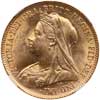 |
Great Britain. Half Sovereign, 1901 NGC MS63. S.3878; Fr-397; KM-784. Victoria. Old head. With good eye appeal. NGC graded MS-63. Estimated Value $275 - 325
View details and enlarged photos
| Unsold |
Lot 2319 |
 |
Great Britain. Coronation Gold and Silver Proof Set, 1902 Proof. KM-PS15; S.PS9. Edward VII. Set contains the Gold 5 and 2 Pounds; Sovereign and Half Sovereign: Silver Crown thru Maundy Set. The four Gold coins grade as follows: ½ Sovereign NGC PF-61 Matte, Sovereign NGC PF-63 Matte, 2 Pound NGC PF-62 Matte, and 5 Pound NGC PF-61 Matte. Lot of 13 coins. Matte Proof. Estimated Value $12,500 - 15,000
View details and enlarged photo
| Realized
$10,575 |
Lot 2320 |
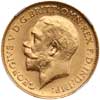 |
Great Britain. Half Sovereign, 1912 NGC MS63. S.4006; KM-819. Weight 0.1177 ounce. George V. NGC graded MS-63. Estimated Value $175 - 200
View details and enlarged photos
| Realized
$188 |
Lot 2321 |
 |
Great Britain. Sovereign, 1916 NGC MS64. S.3996; Fr-404; KM-820. George V. NGC graded MS-64. Estimated Value $450 - 500
View details and enlarged photos
| Realized
$470 |
Lot 2322 |
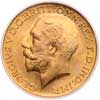 |
Great Britain. Sovereign, 1925 ICG MS67. S.3996; KM-820. George V. ICG graded MS-67 Silver Wings. Estimated Value $500 - 600
View details and enlarged photos
| Unsold |
|
|